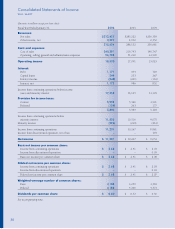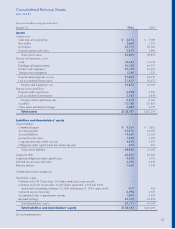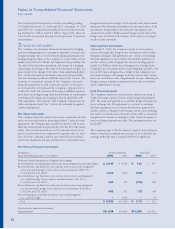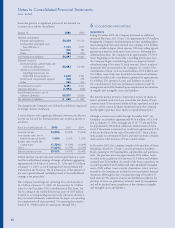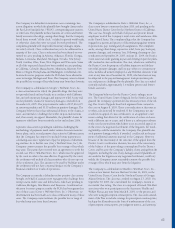Walmart 2006 Annual Report Download - page 38
Download and view the complete annual report
Please find page 38 of the 2006 Walmart annual report below. You can navigate through the pages in the report by either clicking on the pages listed below, or by using the keyword search tool below to find specific information within the annual report.
Notes to Consolidated Financial Statements
WAL-MART
36
Advertising Costs
Advertising costs are expensed as incurred and were $1.6 billion,
$1.4 billion and $966 million in fi scal 2006, 2005 and 2004,
respectively. Advertising costs consist primarily of print and televi-
sion advertisements.
Pre-Opening Costs
The costs of start-up activities, including organization costs and
new store openings, are expensed as incurred.
Share-Based Compensation
The Company recognizes expense for its share-based compensation
based on the fair value of the awards that are granted. The fair value
of stock options is estimated at the date of grant using the Black-
Scholes-Merton option valuation model which was developed for
use in estimating the fair value of exchange traded options that have
no vesting restrictions and are fully transferable. Option valuation
methods require the input of highly subjective assumptions, includ-
ing the expected stock price volatility. Measured compensation cost
is recognized ratably over the vesting period of the related share-
based compensation award.
Share-based compensation awards that may be settled in cash are
accounted for as liabilities and marked to market each period.
Insurance/Self-Insurance
The Company uses a combination of insurance, self-insured reten-
tion and self-insurance for a number of risks, including, without
limitation, workers’ compensation, general liability, vehicle liability
and the Company-funded portion of employee-related health care
benefi ts. Liabilities associated with these risks are estimated in part
by considering historical claims experience, demographic factors,
frequency and severity factors and other actuarial assumptions.
Depreciation and Amortization
Depreciation and amortization for fi nancial statement purposes
are provided on the straight-line method over the estimated useful
lives of the various assets. Depreciation expense, including amorti-
zation of property under capital leases for fi scal years 2006, 2005
and 2004 was $4.7 billion, $4.3 billion and $3.9 billion, respec-
tively. For income tax purposes, accelerated methods of deprecia-
tion are used with recognition of deferred income taxes for the
resulting temporary differences. Leasehold improvements are depre-
ciated over the shorter of the estimated useful life of the asset or the
remaining lease term. Estimated useful lives for fi nancial statement
purposes are as follows:
Buildings and improvements 5 – 50 years
Fixtures and equipment 3 – 12 years
Transportation equipment 3 – 15 years
Income Taxes
Income taxes are accounted for under the asset and liability
method. Deferred tax assets and liabilities are recognized for the
estimated future tax consequences attributable to differences
between the fi nancial statement carrying amounts of existing
assets and liabilities and their respective tax bases. Deferred tax
assets and liabilities are measured using enacted tax rates in effect
for the year in which those temporary differences are expected
to be recovered or settled. The effect on deferred tax assets and
liabilities of a change in tax rate is recognized in income in the
period that includes the enactment date. Valuation allowances are
established when necessary to reduce deferred tax assets to the
amounts more likely than not to be realized.
In determining the quarterly provision for income taxes, the
Company uses an annual effective tax rate based on expected
annual income and statutory tax rates. The effective tax rate also
refl ects the Company’s assessment of the ultimate outcome of tax
audits. Signifi cant discrete items are separately recognized in the
income tax provision in the quarter in which they occur.
The determination of the Company’s provision for income taxes
requires signifi cant judgment, the use of estimates, and the interpre-
tation and application of complex tax laws. Signifi cant judgment is
required in assessing the timing and amounts of deductible and tax-
able items. Reserves are established when, despite management’s
belief that the Company’s tax return positions are fully supportable,
management believes that certain positions may be successfully
challenged. When facts and circumstances change, these reserves
are adjusted through the provision for income taxes.
Net Income Per Common Share
Basic net income per common share is based on the weighted-
average outstanding common shares. Diluted net income per com-
mon share is based on the weighted-average outstanding shares
adjusted for the dilutive effect of stock options and restricted stock
grants. The dilutive effect of stock options and restricted stock was
5 million, 7 million and 10 million shares in fi scal 2006, 2005 and
2004, respectively. The Company had approximately 57 million,
59 million and 50 million option shares outstanding at January 31,
2006, 2005 and 2004, respectively, which were not included in the
diluted net income per share calculation because their effect would
be antidilutive as the underlying option price exceeded the average
market price of the stock for the period.
Estimates and Assumptions
The preparation of consolidated fi nancial statements in conformity
with generally accepted accounting principles requires Management
to make estimates and assumptions. These estimates and assump-
tions affect the reported amounts of assets and liabilities. They also
affect the disclosure of contingent assets and liabilities at the date
of the consolidated fi nancial statements and the reported amounts
of revenues and expenses during the reporting period. Actual
results may differ from those estimates.
Reclassifi cations
Certain reclassifi cations have been made to prior periods to conform
to current presentations.






